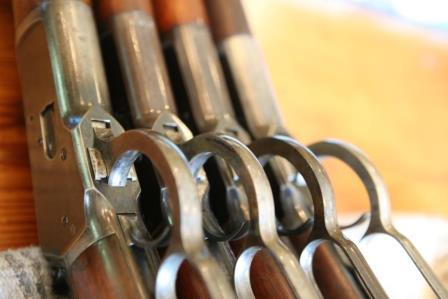July 31, 2005
 Offline
OfflineHi Don,
I have owned two rifles that have this sight. Both are 1876 Express rifles. I don’t have any stellar knowledge on how to avoid breaking the leaves. I get fingernails of both hands under the leaf on each side then raise it with equal pressure.
I don’t have an explanation why so many of these have broken leaves. Many of the ones I see on eBay have broken leaves. Maybe that’s why they got removed?
I call myself a collector as it sounds better than hoarder
November 1, 2013
 Offline
OfflineBill Hockett said
I don’t have an explanation why so many of these have broken leaves.
I think it’s nothing more mysterious than that, being a secondary sight, they tended to be used very little, so after years of disuse became “glued” down with dried oil & grime, maybe some unnoticed rust. Then when someone finally tried to move them, snapped off where they are attached (soldered?) to the collar that surrounds the axle they turn on.
January 26, 2011
 Offline
OfflineI have quite a few of them, mainly on 1894 ELWs. All I can say is soak them with Kroil before trying anything. I’ve had some luck getting my thumb just right in the rear set of leaves and rocking it back (rather than pulling). Sometimes it just goes easily like pushing a button, but most times it ends with serious pain to my thumb!
I can also say if you are moving the forward thin leaf by itself it is pretty fragile so you have to use caution pushing it back down to use the middle leaf.
I cant compete with Bills photo of a 34 on a matted barrel, but here’s a few I have.

~Gary~

January 27, 1992
 Offline
OfflinePersonally, I found it easiest when raising from lowest to the middle leaf, use the tallest (third) leaf to do the change. Then return it to the down position. There is better leverage and the third sight is generally thicker thus stronger. Using both “ears” makes it even easier and spreads the pressure over a larger surface area. RDB
January 26, 2011
 Offline
OfflineI think the final consensus aligns with what you first posted “These are very attractive looking sights, but not very user friendly.”
Even when you get them freed up with Kroil or something similar, they are still hard to rock back without a little pain involved. I wouldn’t want to be trying to switch leaves during a hunt when some trophy game was walking by.
~Gary~

November 1, 2013
 Offline
Offlinepdog72 said
I think the final consensus aligns with what you first posted “These are very attractive looking sights, but not very user friendly.”
Any rifle equipped with one of these presumably had a tang sight, a Lyman 21, or something else as its primary sight. In other words, they were dressy slot-fillers. Which is why I said that “disuse” led to their becoming inoperative. If a shooter was flipping them up & down on a regular basis, they’d never become stuck together, leading to breakage.
March 20, 2009
 Offline
Offlinepdog72 said
“These are very attractive looking sights, but not very user friendly.”
I wouldn’t want to be trying to switch leaves during a hunt when some trophy game was walking by.
I do a fair amount of archery hunting for hogs and deer. A typical “shoot scenario” kind of goes like this. Animal shows up, You pick up a range finder, target the animal and determine the distance. Put the rangefinder into your pocket or on the ground. Pick up and or raise your bow. Attach the release to the D loop on the bow string and pull the arrow back and finally sight the animal and determine shot placement. HOPEFULLY the target has not moved very far since you used the range finder or you may have to release the tension on the bow and repeat the process. All of this can take several seconds. I would estimate it to be easily 10 seconds at the least. So switching leaves on a sight seems to be infinitely easier and quicker to me. Certainly no more “cumbersome” than trying to determine which little notch the elevator is set at ion your typical buckhorn sight. Which if you are going from let’s say 150 yards to 50 yards will take both hands to do it.
clarence said
pdog72 said
I think the final consensus aligns with what you first posted “These are very attractive looking sights, but not very user friendly.”
Any rifle equipped with one of these presumably had a tang sight, a Lyman 21, or something else as its primary sight. In other words, they were dressy slot-fillers.
This doesn’t seem practical since a folding peep sight is only good for one distance setting since the height is set. Not exactly a good scenario when you don’t know the distance you may be shooting.
Michael

Model 1892 / Model 61 Collector, Research, Valuation
November 1, 2013
 Offline
Offlinetwobit said
This doesn’t seem practical since a folding peep sight is only good for one distance setting since the height is set. Not exactly a good scenario when you don’t know the distance you may be shooting.
So how do you “know” the distance without a laser range-finder? Using your best judgement, you guesstimate, & adjust your hold accordingly, as hunters have been doing since the earliest days of shooting.


 Log In
Log In





 Online
Online

